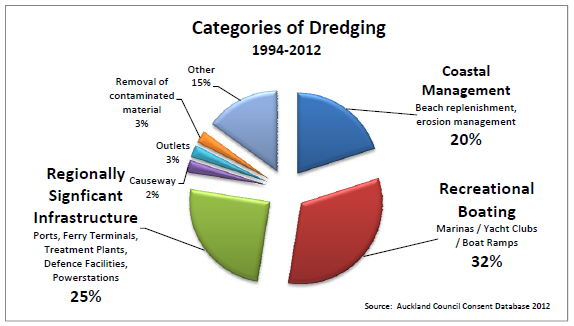Components of major marine developments
Major marine developments include a number of components each of which have different environmental effects.
Large fixed structures
A wide variety of structures have been placed in the coastal marine area. These include relatively small objects such as moorings and navigational aids, as well as larger fixed structures that are rigidly attached to the seabed, such as wharves, breakwaters, seawalls, causeways and groynes. Some developments, such as ports and marinas, require the construction of a large number of structures within a confined location of the coastal marine area together with extensive development above mean high water springs.
A marina development is likely to inclu.de numerous piles and floating pontoons to create marina berths and fuelling facilities, breakwaters to protect the boats from wave damage, slipways, haul out facilities and washdown areas for boat maintenance, boat ramps, and onshore facilities such as hard stand areas, administration and toilet blocks, shops, cafes and car parks.
Canal developments typically include seawalls around the edges of the canals, piles and floating pontoons to provide berths adjacent to the canal-side homes and may include bridges or causeways to provide pedestrian and/or vehicle access across the canals. Onshore structures typically include houses, apartments and commercial developments. A marina may be included as an integral part of a canal development.
Tidal energy can be exploited by building semi-permeable barrages across estuaries or by harnessing offshore tidal streams. 1c71a571-335c-479f-9fdf-276457e1ebc6 In 2011, a ten-year consent was granted to construct a marine tidal turbine power station in the mouth of the Kaipara Harbour. The consent provided for 200 completely submerged marine tidal turbines with a maximum generating capacity of around 200MW to be located underwater, but has yet to be constructed.
Dredging and Disposal
Dredging of the seabed is commonly undertaken to increase, maintain or restore navigable water depths in the coastal marine area, particularly in association with ports, marinas and canal developments. There are two kinds of dredging: capital dredging which aims to physically change the depth of the seabed permanently; and maintenance dredging which aims to maintain a depth of the seabed. The figure below shows the different activities for which dredging consents have been granted in the Auckland region between 1994 and 2012.

Canal developments in New Zealand have, to date, been constructed on low-lying land adjacent to estuaries, inlets and harbours. Some areas, historically, were coastal wetlands. The canals are dug out of land above mean high water springs, lined with seawalls, and then flooded when the area is opened up to the sea. This approach has avoided the need for canals to be dug within the existing marine environment. Seabed dredging is usually required, however, to create a navigation channel between the canal development and the open sea.
To accommodate the growing size of international ships, capital dredging has also been undertaken at commercial ports to increase the navigable depths within major shipping channels and near wharves. This mirrors an international trend in deep water port developments. A number of the larger ports are in the process of a major development to support the next generation of container ships, including the Port of Tauranga and Port Otago. The Port of Tauranga, the country’s largest port by volume exported, is currently dredging to deepen the shipping channel from 12.9 metres to 16.0 metres depth at low water,. This is to provide sufficient draught for larger ships which carry many more containers.
2c6398d2-5a14-4333-8074-48cc4319b9a3
Maintenance dredging is often required to maintain access to ports, wharves, marinas and canal developments. This is particularly the case in enclosed harbours and sheltered bays, where there is a large quantity of sediment running off the land into waterways, and little energy from waves or currents to disperse the sediment before it settles onto the seabed.
Reclamation and declamation
Reclamation and declamation of coastal land alters the shape of the coastline to provide for development, by adding or removing material from the coastal marine area. Reclamation has been undertaken extensively in many parts of the country to provide for extensions of the urban environment. Indeed, in cities such as Auckland, Wellington and Dunedin reclaimed land forms a significant part of the central business district. Approximately 10 per cent of the area of Auckland’s Waitematā Harbour has been reclaimed since 1840. Today, there is a greater understanding of the negative environment impacts of reclamation, and little is undertaken for urban expansion. Reclamation is still undertaken, however, for port and marina developments. Some of these reclamations have included dredged material, such as at the Fergusson terminal container.
317404b7-84c1-4f8b-abef-1294d571d901
Declamation has been an integral component of canal developments in New Zealand, where land is removed, allowing the sea to expand into new areas. Such projects tend to occur in estuaries, wetlands and other parts of the coastal marine area where the water is shallow and the new structures will be protected from the worst of the coastal weather.
-
http://www.oceanenergycouncil.com/ocean-energy/tidal-energy/
-
http://www.stuff.co.nz/waikato-times/business/8383777/Port-of-Tauranga-given-green-light-for-bigger-ships
-
http://www.poal.co.nz/community_environment/dredging.htm
Last updated at 2:11PM on February 25, 2015